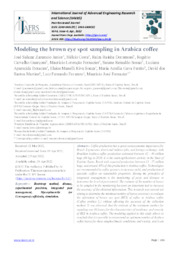Modeling the brown eye spot sampling in arabica coffee.
Modeling the brown eye spot sampling in arabica coffee.
Autoria: ZANUNCIO JUNIOR, J. S.; COSTA, H.; DORZENONI, R. R.; GUARÇONI, R. C.; FORNAZIER, M. L.; SOSSAI, S. R.; BOTACIM, L. A.; SOUZA, E. M. R.; FERRAO, M. A. G.; MARTINS, D. dos S.; FAVARATO, L. F.; FORNAZIER, M. J.
Resumo: Coffee production has a great socioeconomic importance for Brazil. It generates direct and indirect jobs, and foreign exchange, with Brazilian Arabica coffee production estimated between 42 - 46 million bags (60 kg) in 2020. It is the main agribusiness activity in the State of Espírito Santo, Brazil with expected production between 13 - 15 million bags, and around 30% of this production is Arabica coffee. Technologies are recommended to coffee growers to increase yield, and production of specialty coffees on sustainable properties. Among the principles of integrated management is the monitoring of pests and diseases to determine the level of pest control. The estimate of the number of leaves to be sampled in the monitoring becomes an important tool to increase the accuracy of the obtained information. This research was carried out aiming to determine the minimum number of leaves necessary to evaluate the infestation of brown eye spot (BES) of coffee in Arabica coffee (Coffea arabica L.) without affecting the accuracy of the collection method. It was observed that the estimate of the minimum number for sampling was 46 leaves for the characteristics of incidence, and severity of BES in Arabica coffee. The modeling applied in this study allows to conclude that it is possible to recommend an optimum number of Arabica coffee leaves for these edaphoclimatic conditions, and variety, and it can serve as a basis for monitoring in an integrated pest and disease management program in Arabica coffee.
Ano de publicação: 2022
Tipo de publicação: Artigo de periódico
Unidade: Embrapa Café
Palavras-chave: Cercospora, Coffea arabica var. arabica, Disease surveillance, Mycosphaerella, Pest control, Peste
Observações
1 - Por padrão são exibidas publicações dos últimos 20 anos. Para encontrar publicações mais antigas, configure o filtro ano de publicação, colocando o ano a partir do qual você deseja encontrar publicações. O filtro está na coluna da esquerda na busca acima.
2 - Para ler algumas publicações da Embrapa (apenas as que estão em formato ePub), é necessário ter, no celular ou computador, um desses softwares gratuitos. Sistemas Android: Google Play Livros; IOS: iBooks; Windows e Linux: software Calibre.
Acesse outras publicações
Acesse a Base de Dados da Pesquisa Agropecuária (BDPA) para consultar o acervo completo das bibliotecas da Embrapa.

